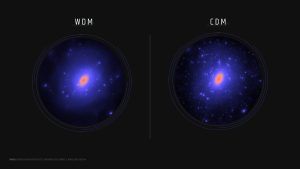This shows the result of two numerical simulations predicting the distribution of dark matter around a galaxy similar to our Milky Way. The left panel assumes that dark matter particles were moving fast in the early universe (warm dark matter), while the right panel assumes that dark matter particles were moving slowly (cold dark matter). The warm dark matter model predicts many fewer small clumps of dark matter surrounding our galaxy and thus many fewer satellite galaxies that inhabit these small clumps of dark matter. By measuring the number of satellite galaxies, scientists can distinguish between these models of dark matter. Image: Bullock and Boylan-Kolchin (2017); simulations by V. Robles, T. Kelley and B. Bozek, in collaboration with Bullock and Boylan-Kolchin

